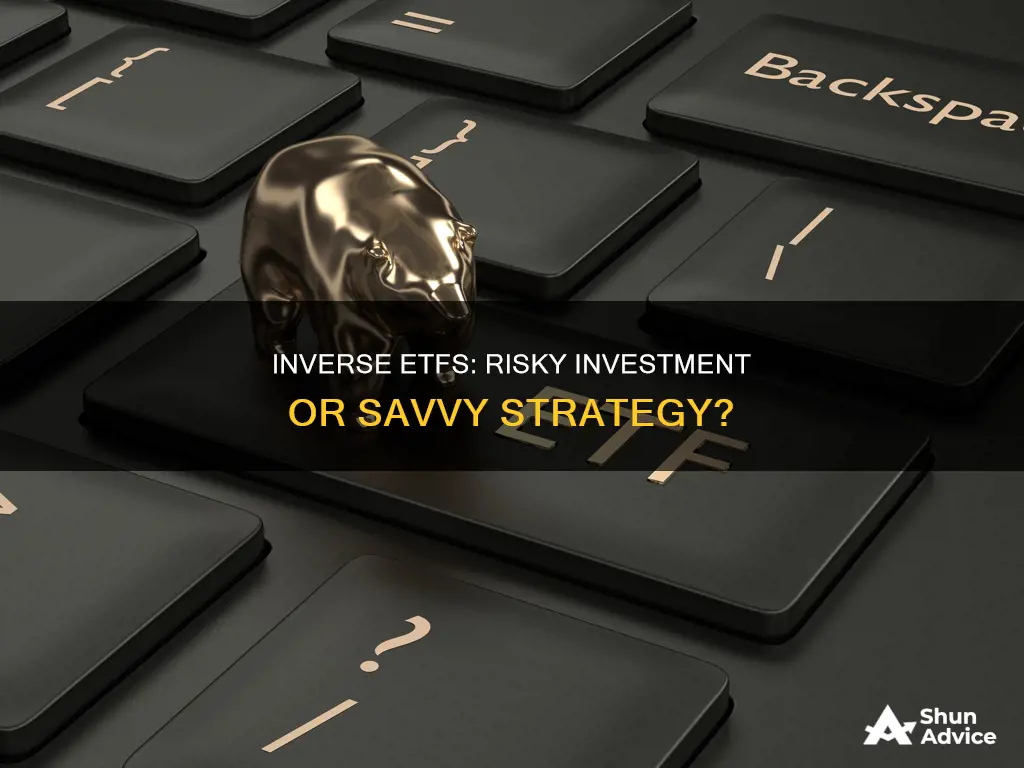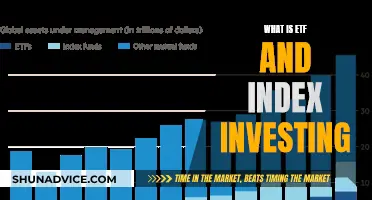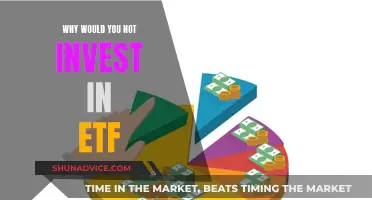
Inverse ETFs are a type of exchange-traded fund (ETF) that allows investors to profit from market declines. They are designed for short-term strategies, with the intention of being bought and sold within a single day. Inverse ETFs are a way to benefit from drops in the market without having to short a security.
Inverse ETFs are risky and speculative investments that aim to achieve goals similar to short selling. They are designed for sophisticated, highly risk-tolerant investors who are comfortable with the risks involved. Inverse ETFs are also subject to high fees and transaction costs, which can erode investment returns.
While inverse ETFs can be a valuable tool for seasoned market professionals, they are not suitable for everyone. It is important for investors to carefully consider the risks and rewards before investing in inverse ETFs.
| Characteristics | Values |
|---|---|
| Purpose | To profit from market declines |
| Type of investment | Speculative short-term investment |
| Holding period | One day |
| Advantage | No need for a margin account |
| Advantage | No need to open futures and/or options trading accounts |
| Advantage | Access to professional investment management |
| Risk | Complicated and risky |
| Risk | Volatility loss |
| Risk | Compounding risk |
| Risk | Derivative securities risk |
| Risk | Correlation risk |
| Risk | Short sale exposure risk |
What You'll Learn

Inverse ETFs are risky and complicated
Risky and Speculative
Inverse Exchange-Traded Funds (ETFs) are designed to profit from market declines, making them risky and speculative investments. They are intended for traders who want to bet against the market or hedge their portfolios against market risk. Inverse ETFs aim to achieve goals similar to short selling, which is a risky strategy where traders borrow and sell securities, expecting the price to fall so they can repurchase them at a lower price.
Complex Investment Strategies
Inverse ETFs use complex investment strategies, often involving leverage and derivative instruments such as options, swaps, and futures. These aggressive strategies are not suitable for all investors and can lead to substantial losses. The use of derivatives and leverage can create additional risks, including correlation risk, credit risk, liquidity risk, and short sale exposure risk.
High Fees and Expenses
Inverse ETFs typically have high expense ratios and fees, which can significantly erode investment returns. The complex financial instruments and active management involved in inverse ETFs result in above-average expenses. These costs can add up over time and impact the overall returns of the investment.
Compounding Risk
Inverse ETFs are designed for daily trading and have single-day investment objectives. Holding inverse ETFs for longer periods can result in compounding returns that differ from their intended investment goals. Investors who hold inverse ETFs for more than a day must actively manage and rebalance their positions to mitigate this risk.
Volatility Loss
Inverse ETFs can be susceptible to volatility loss, which occurs when the underlying security experiences significant volatility. Even if the underlying security declines in value, the inverse ETF may still lose value due to the impact of volatility on total returns. This means that investors can be correct in their directional assessment but still lose money by investing in an inverse ETF.
Not Suitable for Risk-Averse Investors
Inverse ETFs are best suited for sophisticated and highly risk-tolerant investors who understand the inherent risks. They are not suitable for risk-averse investors or those seeking long-term investments. The complexity, volatility, and potential for significant losses make inverse ETFs a risky choice for certain investors.
A European's Guide to US ETF Investing
You may want to see also

They are intended for short-term speculation
Inverse ETFs are designed for short-term speculation. They are intended to be bought and sold within a single day and are not suitable for long-term investment strategies.
Inverse ETFs are risky and speculative investments that aim to achieve goals similar to short selling. They are designed for investors who want to profit from market declines. As a result, they are often referred to as "short" or "bear" ETFs.
Inverse ETFs are typically used by contrarian traders or seasoned market professionals. They are not suitable for risk-averse investors due to their complex nature and the potential for significant losses.
Inverse ETFs are also subject to various risks, such as compounding risk, derivative securities risk, correlation risk, and short sale exposure risk. Compounding risk, in particular, can significantly impact the returns of inverse ETFs held for more than a day.
While inverse ETFs can be a valuable tool for short-term speculation, they should be approached with caution and a thorough understanding of the associated risks.
A Simple Guide to STI ETF Investment
You may want to see also

Inverse ETFs can be used to hedge a portfolio
Inverse ETFs are a convenient way to maximize investment returns regardless of market direction. They seek investment results that correspond to the inverse of the benchmark or index with which they are associated. For example, if you anticipate a downturn in the Nasdaq 100, you can buy shares in the ProShares Short QQQ ETF (PSQ), which seeks results that correspond to the inverse of the performance of the Nasdaq 100 Index.
Inverse ETFs are also useful for investors who want to hedge against rising interest rates. For example, the ProShares Short 20+ Year Treasury ETF (TBF) seeks daily inverse exposure to the ICE U.S. Treasury 20+ Year Bond Index.
It is important to note that inverse ETFs are typically used as a short-term strategy rather than a long-term investment. They are considered riskier than traditional ETFs due to their use of derivatives and leverage, which can lead to higher volatility and potential losses. As such, investors should carefully consider their investment objectives, level of financial knowledge, and risk tolerance before investing in inverse ETFs.
TFSA ETF Investment: A Guide to Getting Started
You may want to see also

They are designed for sophisticated, highly risk-tolerant investors
Inverse ETFs are designed for sophisticated, highly risk-tolerant investors. They are complex and risky investment products that require a high level of financial knowledge and engagement. Inverse ETFs are intended for short-term positions and are often used by experienced traders to hedge against falling prices in other positions or to make directional bets on securities or indices.
Inverse ETFs are exchange-traded funds (ETFs) that bet against the expected daily performance of an asset or market index. They are designed to achieve investment results that correspond to the inverse (opposite) of the benchmark or index they are associated with. For example, if the S&P 500 index increases by 1%, an inverse ETF tracking that index should theoretically decrease by 1%. These ETFs are constructed using derivative securities such as swaps, futures contracts, and options, which expose them to additional risks.
One of the main risks of inverse ETFs is compounding risk. These ETFs are designed to provide inverse returns for a single day, and their performance can differ significantly from their investment objective when held for longer periods. Investors who wish to hold inverse ETFs for more than a day must actively manage and rebalance their positions to mitigate this risk.
Another risk to consider is derivative securities risk. Many inverse ETFs employ derivatives such as swaps, futures, and options, which are considered aggressive investments. These derivatives expose inverse ETFs to correlation risk, credit risk, and liquidity risk. Correlation risk refers to the potential for the ETF's performance to deviate from its underlying index due to high fees, transaction costs, expenses, and investing methodologies. Credit risk arises when a counterparty is unable or unwilling to meet its obligations, leading to a decline in the value of swap agreements. Liquidity risk means that inverse ETFs holding derivative securities may face challenges in buying or selling their holdings in a timely manner or at a reasonable price.
Inverse ETFs also carry short sale exposure risk. By using derivatives such as swaps and futures contracts, inverse ETFs may be exposed to the risks associated with short-selling securities, including increased volatility and decreased liquidity of the underlying securities. These risks can lead to lower returns or losses for short-selling funds.
Overall, inverse ETFs are sophisticated investment products that are not suitable for risk-averse investors. They are designed for investors who are comfortable with taking on high levels of risk and have the necessary financial knowledge to actively manage and rebalance their positions.
Best ETFs to Invest in This Year
You may want to see also

Inverse ETFs can be traded through a standard brokerage account
Inverse ETFs are a type of exchange-traded fund (ETF) that bets against the expected daily performance of an asset or market index. They are often used by contrarian traders looking to profit from the decline in value of an asset class, such as stocks or bonds.
When considering investing in inverse ETFs, it is crucial to understand the risks involved. These include the potential for significant losses, the effect of compounding and rebalancing, and the impact of market volatility. Additionally, inverse ETFs have above-average expenses, which can impact the overall returns.
It is also important to have a good understanding of day trading and to be able to focus time and attention on managing the investment. Inverse ETFs are not suitable for a buy-and-hold strategy and are better suited to experienced traders who can actively monitor and manage their investments.
A Guide to Investing in Bharat 22 ETF
You may want to see also







